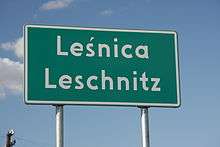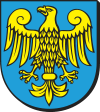Leśnica
| Leśnica Leschnitz | |||
|---|---|---|---|
|
Main Square | |||
| |||
 Leśnica Leschnitz | |||
| Coordinates: 50°25′45″N 18°10′52″E / 50.42917°N 18.18111°ECoordinates: 50°25′45″N 18°10′52″E / 50.42917°N 18.18111°E | |||
| Country |
| ||
| Voivodeship | Opole | ||
| County | Strzelce Opolskie | ||
| Gmina | Leśnica | ||
| Established | 13th century | ||
| Town rights | 1217 | ||
| Government | |||
| • Mayor | Hubert Kurzał | ||
| Area | |||
| • Total | 14.45 km2 (5.58 sq mi) | ||
| Elevation | 205 m (673 ft) | ||
| Population (2007) | |||
| • Total | 2,905 | ||
| • Density | 200/km2 (520/sq mi) | ||
| Time zone | CET (UTC+1) | ||
| • Summer (DST) | CEST (UTC+2) | ||
| Postal code | 47-150 | ||
| Area code(s) | +48 77 | ||
| Car plates | OST | ||
| Website | Official website | ||
Leśnica [lɛɕˈɲit͡sa] (German: Leschnitz, 1936-45 Bergstadt; Silesian: Leźńica) is a town in Poland. Since 1999 it has been in Strzelce Opolskie County in Opole Voivodship.
History

.jpg)
The town, which was first documented in 1217, was destroyed in 1429 during the Hussite Wars. As Leschnitz, it was annexed by the Kingdom of Prussia in 1742 during the First Silesian War. The town was included in Landkreis Groß Strehlitz within the Prussian Province of Silesia in 1816. Leschnitz became part of the German Empire in 1871 during the unification of Germany. In 1936 while part of the Province of Upper Silesia, it was renamed Bergstadt (mountain town). In 1945 it was placed under Polish administration according to the Potsdam Agreement and renamed Leśnica. Due to fact that no less than 20% of its population belongs to the German minority in Poland, the town uses bilingual Polish and German signs and language —Polish remains official, German is the language of "assistance".
Notable people
- Theodor Aufrecht (1822–1907), indologist
- Eugen Piwowarsky (1891–1953), metallurgist
- Gerhard Schaffran (1912-1996), Catholic bishop of Dresden-Meißen
International relations
Twin towns — Sister cities
Leśnica is twinned with:
External links
- Jewish Community in Leśnica on Virtual Shtetl


